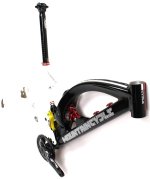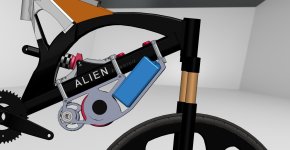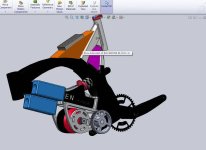panurge
10 kW
Hi Bruno
I look with interest at your build and mostly at your esc application in E-bike, with this kind of motor I guess you'll go with the 400amp one....please keep us informed on this...I think you have the chance to play with escs, that's the most critical part of an RC build.
Your frame looks good...seems you are going for a Pivot point concentric to the BB....notice that's not the best way to go for a single pivot if a good pedal feeling is still requested, well, obviously it solves most issues on the chain tension side....
As mentioned, Motomoto, with his top build, Is maybe the one that pushed the max power thru the gears around here.....there's a lot of difference In what you may push on a derailleur setup, I think, depends from the component's material and quality, mostly about cogs, chain, derailleur, freehub, bearings and Drive sprocket.....anyway it is not a bad Idea, in the gearing plan, to use a 13t or even 14t or 15t as the smaller cassette cog (driven by the motor, at least). This should increase critically the power limit.
Buon lavoro :wink:
I look with interest at your build and mostly at your esc application in E-bike, with this kind of motor I guess you'll go with the 400amp one....please keep us informed on this...I think you have the chance to play with escs, that's the most critical part of an RC build.
Your frame looks good...seems you are going for a Pivot point concentric to the BB....notice that's not the best way to go for a single pivot if a good pedal feeling is still requested, well, obviously it solves most issues on the chain tension side....
As mentioned, Motomoto, with his top build, Is maybe the one that pushed the max power thru the gears around here.....there's a lot of difference In what you may push on a derailleur setup, I think, depends from the component's material and quality, mostly about cogs, chain, derailleur, freehub, bearings and Drive sprocket.....anyway it is not a bad Idea, in the gearing plan, to use a 13t or even 14t or 15t as the smaller cassette cog (driven by the motor, at least). This should increase critically the power limit.
Buon lavoro :wink:






